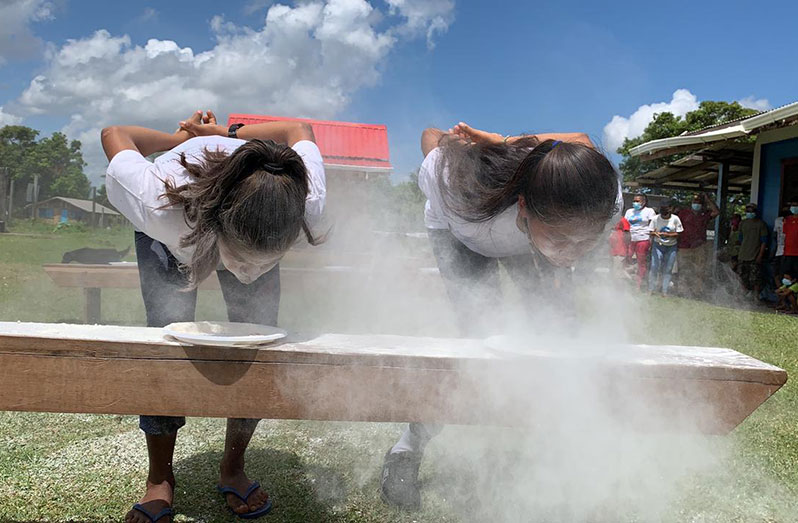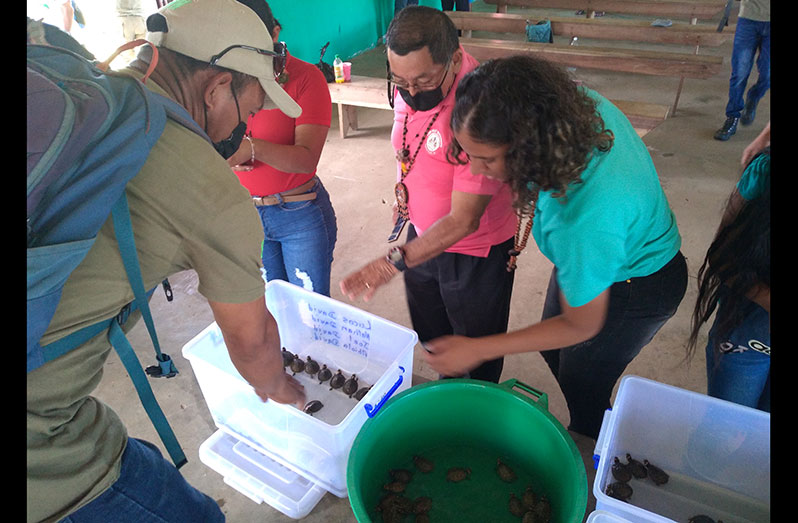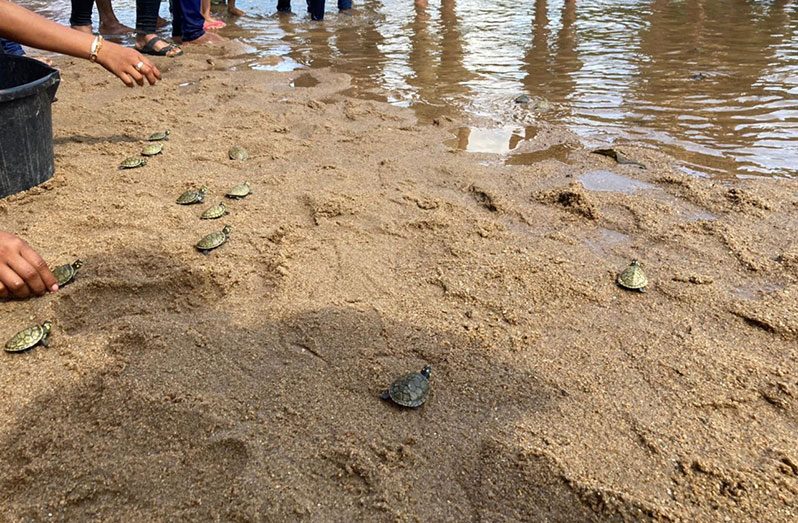SRCS project promotes preservation of turtle population
VILLAGERS in the South Rupununi have been coming together for years to enjoy a ‘turtle feast’ around Christmas time, but earlier this month, for the first time in the history of the South Rupununi district, and in an effort to preserve the turtle population, villages came out to instead release 200 turtles into the river that they’ve nurtured from the egg stage.
In the early 1990s, residents of Sand Creek Village in South Central Rupununi, Region Nine, saw turtles in abundance every time they went to the river. In fact, as part of their cultural traditions, the village would have a turtle feast whereby they would catch as many turtles as possible and eat them together some time during the holidays.

The last known feast was in the early 2000s when 93 turtles were caught for consumption. In previous years, however, the numbers caught were significantly higher. The residents of Sand Creek, though, especially the village elders, have noticed a serious decline in the turtle population.
“The obvious main threat for this was the overharvesting that occurred not only at Christmas time, but throughout the year. In addition to the village catching adults, villagers also frequently go to the beaches along the Rupununi River during the hatching season to collect eggs to eat as they are a local delicacy,” Programme Coordinator of the South Rupununi Conservation Society (SRCS), Neal Millar, told Pepperpot Magazine.

In response to the decline, the SRCS offered to collaborate with the village to start a turtle conservation project which involved training eight villagers from Sand Creek to become ‘turtle rangers,’ who would monitor eight beaches along the Rupununi River during the hatching season this year (January 2021 to April 2021) to prevent persons from the village disturbing the eggs on the beaches.
However, an unseasonal early rainy season caused the water level of the Rupununi River to rapidly rise and caused all of the beaches to become flooded. The rangers out on the river did not know what to do as something like this had not happened before and therefore was not planned for.

“They acted on their own instinct and worked day and night to rescue all the eggs from the nests that they had identified on the eight beaches. In total, the rangers rescued over 400 eggs and brought them back to the village where they shared them amongst themselves to look after. After about two weeks in the village, nearly all the eggs hatched. From April to September, the rangers looked after the turtles in their personal homes. If they had not rescued them, all 400 eggs would have perished,” Millar shared.
It was when the turtles became big enough that the rangers and SRCS decided to host the turtle festival last week to release 200 of the turtles, with the other 200 being kept by the rangers for release at a later time.
While there has been a turtle festival of this sort in Yupukari Village in the North Rupununi, nothing like this has ever been done in the south. “It is equally important to do this in the south, as the turtles can be found all throughout the Rupununi River and if only one side protects them, they will still be overharvested,” Millar believes.

Following COVID-19 guidelines, only the residents of Sand Creek village were invited for the festival even as plans are on stream to invite everyone from the Rupununi in the years to come once the pandemic has eased.
The festival included a march past, opening songs and dances, activities and games, quizzes, cultural displays and then the grand event of releasing the turtles. The games were all designed to teach both the students and the adults why it is important to not overharvest the turtles as the village needs them for a sustainable food source and also to maintain wildlife diversity.
Regional Chairman of Region Nine, Brian Allicock, was in attendance and he stated his pride at seeing the village moving from consuming the turtles to releasing them. Moving forward, Millar said SRCS will continue to collaborate with Sand Creek Village to protect the beaches for next year’s turtle nesting season (January 2022 to April 2022).
The project was made possible with the support of the Sustainable Wildlife Management Programme Guyana, the Turtle Conservation Fund, ReWild and the Protected Areas Commission.




.png)









